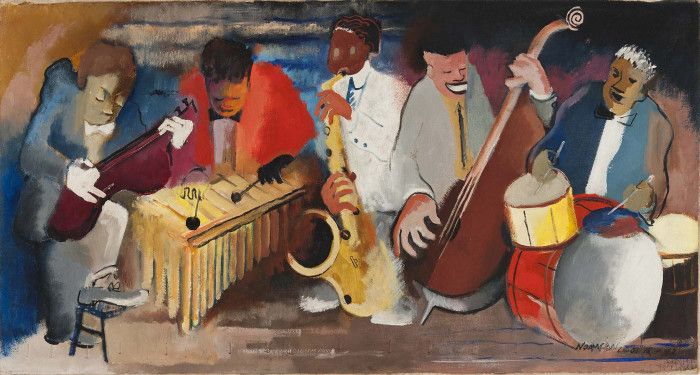Unit 3: The Harlem Renaissance
 |
Norman Wilfred Lewis, 'Jumping Jive' (1942) |
This unit explores the notion of a literary movement through the case of the Harlem Renaissance. What defines a movement? Style, place, groups of people who know each other? The retroactive creation of scholars? Or something else? Are different movements defined as such in different ways? These questions are all in play in modernism, and especially among the modernist writers and artists that we typically associate with the Harlem Renaissance: Langston Hughes, Jesse Fauset, Zora Neale Hurston, Alain Locke, Aaron Douglas, Jacob Lawrence, Claude McKay and others. In these weeks, by reading and viewing major documents by Harlem-based artists, our aim is to assess how movements are made, what makes a movement, and how to read individual texts within this larger unit of study.
Week 12: Statements
Readings:
- In-class: Countee Cullen, “To Certain Critics” (1928)
- Read the Harlem Renaissance cluster from Within the Circle: Literary Criticism from the Harlem Renaissance to the Present (1994, 74 pp.):
Alain Locke, “The New Negro” (1925) — William Stanley Braithwaite, “The Negro in American Literature” (1925) — Jesse Fauset, “The Gift of Laughter” (1925) — George Schuyler, “The Negro-Art Hokum” (1926) — Langston Hughes, “The Negro Artist and the Racial Mountain” (1926) — W.E.B. DuBois, “Criteria of Negro Art” (1926) — Sterling A. Brown, “Our Literary Audience” (1930) — Zora Neale Hurston, “Characteristics of Negro Expression” (1934)
Suggested readings:
- James Weldon Johson, “Preface” to The Book of American Negro Poetry (1922)
- David Levering Lewis, When Harlem Was In Vogue (1981)
- Major Jackson, “Countee Cullen and the Racial Mountain,” Boston Review (2013, link)
- Virtual Harlem (link)
Further reading:
- Hannah Durkin, 'Finding last middle passage survivor Sally "Redoshi" Smith on the page and screen', Slavery and Abolition 40:4 (2019), 631-658 - recounts Zora Neale Hurston's (and others') encounters with the last survivors of the Middle Passage. Slavery was still firmly within living memory at the time of the Harlem Renaissance.
Questions:
- What is an artistic movement?
- What distinguishes the Harlem Renaissance from other artistic movements?
- When did the Harlem Renaissance become a movement?
- What do the eight statements from Within the Circle on black art in America tell us about how the Harlem Renaissance became a movement?
- How do these authors deal with the question of how it feels to be a problem?
- What role does the future play in conceptions of the "New Negro?"
Week 13: Modernism and the Harlem Renaissance
Readings:
- In-Class: Selected images, music & poems
- Nella Larsen, Passing ([1929] 160 pp.)
- Michael North, “Modernism’s African Mask: The Stein-Picasso Collaboration” (59-76) in The Dialect of Modernism: Race, Language, and Twentieth-Century Literature (1994, 17 pp.)
- Deborah McDowell, “Introduction” to Quicksand and Passing (1986)
Suggested readings:
- Michael Levinson, A Genealogy of Modernism: A Study of English Literary Doctrine, 1908-1922 (1986)
- Magazines of the Harlem Renaissance: Fire!! A Quarterly Devoted to Younger Negro Artists (1926, link) — Opportunity (July 1927 issue, link) — The Crisis
Week 14: Modernism and the Harlem Renaissance II
Readings:
- In-Class: Selected images & music, e.g. Jacob Lawrence, Migration Series
- Claude McKay, Home to Harlem [1928, 128 pp., e-book link]
- Houston Baker, from Modernism and the Harlem Renaissance (1987, ~50 pp.)
- W.E.B. DuBois, review of Home to Harlem in The Crisis and McKay’s rejoinder
Questions:
- Where does Home to Harlem fall within African American modernism, which Baker says designates an aesthetic field defined by the two positions above?
- What forms of belonging can you find in the novel? What structures of feeling?
- Is black nationalism and a black nation possible within the world represented in the novel? What about black internationalism?
- What are the obstacles to black nationalism and internationalism?
- Compare Home to Harlem to Passing.
Week 15: Remembering the Harlem Renaissance
Readings:
- August Wilson, Ma Rainey’s Black Bottom (1982)
- Henry Louis Gates, Jr., “Harlem on Our Minds,” Critical Inquiry 24, no. 1 (1997, 12 pp.) and Daylanne English, “Selecting the Harlem Renaissance,” Critical Inquiry 25, no. 4 (1999, 14 pp.)
- Davarian Baldwin and Minkah Makalani, “Introduction: New Negroes Forging a New World” (1-27) in Escape from New York: The New Negro Renaissance Beyond Harlem (2013, 27 pp.)
Suggested readings:
- Lawrence Jackson, “Aftermath: the reputation of the Harlem Renaissance twenty years later,” in A Cambridge Companion to the Harlem Renaissance (2007, 14 pp.)
Questions:
- How can the Harlem Renaissance be said to be a critical construction?
- Do you agree with Daylanne English that the notion of a renaissance, of “rise-and-fall patterns,” is partly a mythic construction created by cultural history?
- What do we make of the alleged paradox identified by Henry Louis Gates that the Harlem Renaissance’s “creation occurred precisely as Harlem was turning into the great American slum”? (11)
- Do you agree with Gates and English that Harlem Renaissance writers largely failed to explore “what the hyphenation of class costs” (English, 816)?
- Do we agree with English’s claim that Henry Louis Gates and other critics of the Harlem Renaissance are guilty of “allowing the writers themselves to determine our understanding of their role in modern culture” (810)?
- Does English contradict herself?
-
What do you make of Baldwin and Makalani’s claim that the New Negro is a “traveling concept” defined not by Harlem but by a series of routes both local and global?
-
How does Escape from New York's change in perspective redefine the New Negro movement?
